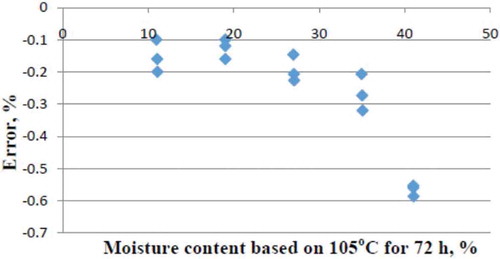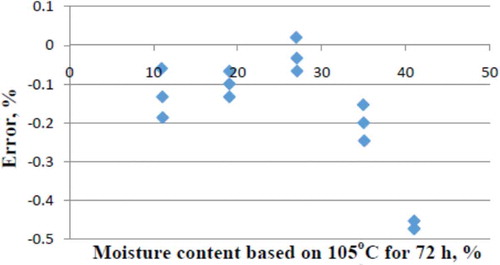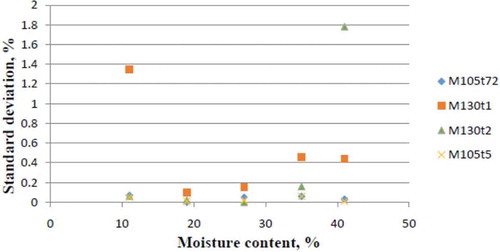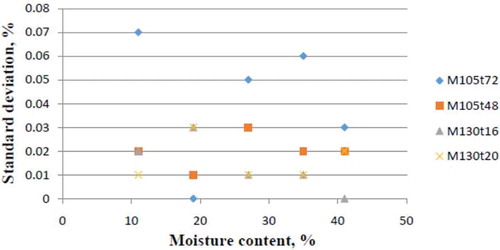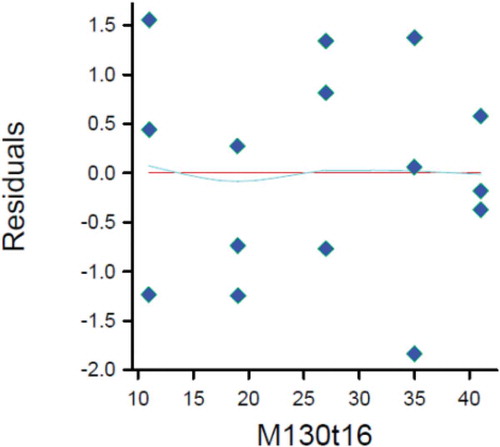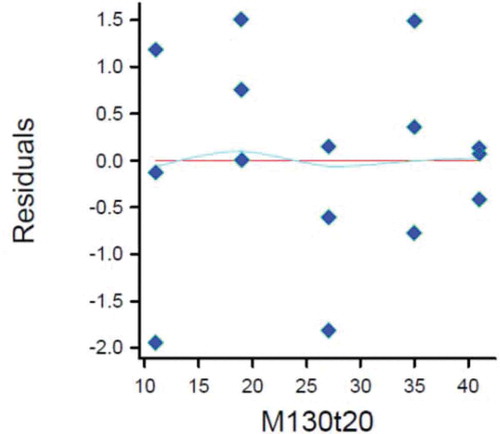Abstract
This study evaluated moisture content determination procedures for pearl millet using seven different air oven methods. The moisture content of the pearl millet samples varied from 11–41% (wet basis). The procedures included 130°C for 1 h; 130°C for 2 h; 105°C for 5 h; 105°C for 48 h; 105°C for 72 h; 130°C for 16 h; and 130°C for 20 h. Analysis of variance revealed that at high moisture content levels above 27% (wet basis), and the mean values of the moisture content determined were not significantly different (p > 0.05). Error analysis carried out showed that the moisture content determination methods were adequate to completely remove the moisture in pearl millet with moisture less than 35% (wet basis). Regression models were developed to predict the base moisture determination method (105°C for 72 h) as a function of other procedures.
INTRODUCTION
The accuracy of moisture content determination methods, which depends on the complete removal of moisture in biomaterials such as grains, meat, forage, pulses, etc., is an important factor during harvest, handling, processing, and storage.[Citation1–Citation3] Inaccurate determination of moisture content of grains could lead to mechanical damage and growth of deleterious fungi while in transit or storage. Such could occur in situations where the grains were harvested, transported and stored at higher moisture content than is required due to inaccurate moisture content determination. In most cases, moisture content influences the selling and buying prices of grains; sellers most often time desire high moisture content grains for increased selling weight while the storability of the produce is of concern to the buyers. In addition to that, accurate moisture content determination is important in the sorting of some agricultural produce prior to drying.[Citation4] Moisture content can be defined on either wet or dry basis. The wet basis moisture content (w.b.) as defined by Chen,[Citation5] is the ratio of the water weight to the initial total weight of the kernels while the dry basis moisture content (d.b.) is defined as the ratio of the water weight to the dried weight of the kernels. There are two basic methods of determining the moisture content of biomaterials: the primary/direct and secondary/indirect methods.[Citation6] In the primary method, water content in the grain is removed totally and the moisture content is calculated while in the secondary method, the moisture content is measured in relation to some physical or chemical characteristics of the grain which affect the moisture content.[Citation5] They are usually calibrated using the primary method.
The removal of water from grains can be achieved through three principal techniques:[Citation5] drying with heated air for a fixed period; distilling with high-temperature oil; and extracting water by solvent. Drying with heated air for a fixed period of time is the simplest among the three and is usually carried out using either a hot air oven or a vacuum oven. Hot air ovens are commonly used as they are less expensive than the vacuum ovens. In most moisture content determination standards, the hot air oven is widely used.[Citation7–Citation10] In the use of a hot air oven, a drying temperature, heating period, and the mass of the grain either whole or ground is usually specified.[Citation10] The Karl Fischer technique[Citation11] and the method outlined by the International Organization for Standardization[Citation12] have been used to standardize simplified oven methods that are regarded as practical working methods.[Citation13] These reference methods are tedious, but were formulated to obtain accurate moisture values for calibration purposes as they are assumed to achieve complete drying of biomaterials without any loss or decomposition.[Citation13]
A number of studies have been carried out on the effect of temperature and time on the accuracy of moisture content determination for different grains using hot air oven, but not for pearl millet (Pennisetum glaucum L.). Six different air oven moisture content determination methods were evaluated by Chen[Citation5] for rough rice. It was reported that all the methods evaluated were inadequate for accurate moisture content determination for rough rice except by heating in hot air oven at 105°C for 72 h. Three different air oven methods (American Society of Agricultural Engineers (ASAE) S352, ISO712-1079, and National Institution of Agricultural Engineers (NIAE) 16 h) were compared to determine the moisture content of barley and wheat at six moisture content levels.[Citation14] It was reported that the mean moisture content determined using the ASAE and NIAE methods were significantly less than the International Organization for Standardization (ISO) 712-1079 oven method. The result of two oven methods for moisture content determination for rough rice were compared by Noomhorm and Verma;[Citation15] the result indicated that moisture content determined by drying whole grains at 130°C for 16 h was higher than the moisture content determined by drying ground grains at 130°C for 1 h. A list of oven methods for whole grains, oilseeds, and vegetable seeds were described in Hart, Feinstein, and Golumbic.[Citation7] The adequate heating temperature and period were determined by comparing the results with that obtained using the Karl Fischer method.[Citation11] However, the moisture content determination method for pearl millet was not included in the list.
Heating whole grain in a hot air oven is the most widely used method for moisture content determination;[Citation10] however, the long drying time necessitated the development of rapid moisture content determination methods using high temperature and shorter time. Such guidelines are expected to produce accurate results. The moisture determination methods of Association of Official Analytical Chemists (AOAC) and ISO R712 use ground samples to reduce the drying period. However, Williams and Sigurdson[Citation16] studied the effect of sample grinding process on the accuracy of moisture determination and reported a significant loss of moisture in the grinding process resulting in measurement errors. The use of whole grain samples rather than ground samples was adopted in ASAE[Citation10] due to simplicity and reduction of the possibility of moisture loss during grinding. Moisture content determination carried out using different oven methods on a grain may not be the same due to the empirical nature of the methods.[Citation13] Furthermore, there is no standard procedure published for the determination of the moisture content of pearl millet (Pennisetum glaucum L.). This has necessitated the need to compare different air oven moisture content determination methods for pearl millet using ASAE[Citation10] as the standard. The objectives of this study were: (1) to determine the effect of air oven drying methods on the moisture content of ground and whole pearl millet grain in the moisture content range of 11.00–41.00% (w.b.); (2) to compare the effects of drying temperature, time, and sample treatment in an air oven on the moisture content of pearl millet using statistical analysis; and (3) to develop regression models for the air oven moisture content determination procedures.
MATERIALS AND METHODS
Sample Preparation
Pearl millet (Pennisetum glaucum L.) was obtained from a local market in Enugu, Nigeria. The bulk was manually cleaned to remove foreign materials. The mean moisture content of the pearl millet recorded as 11.00 ± 0.53% (w.b.) was determined by heating 15 g of the grain at a temperature of 105°C in an air oven (Gallenhamp oven Model No. OV-165)[Citation10] until three consecutive constant weights were recorded using an electronic balance measuring to an accuracy of 0.001 g (Mettler Toledo JL620-GLA01). The grain was divided into five parts and conditioned to five moisture content levels ranging from 11 to 41% (w.b.) using the equilibration method.[Citation17] About 200 g sample of the grain was placed in sealed plastic containers with calculated amounts of distilled water being added (Eq. 1) to bring the grain to the desired moisture content level. The grain samples were kept thereafter in a refrigerator at 2°C for 1 week and shaken periodically to enable the moisture distribute uniformly throughout the sample.[Citation5,Citation17] The moisture content of the grain after conditioning was confirmed following the method adopted from ASAE[Citation10] as earlier described. Before the start of a test, the required quantity of grain was taken out of the refrigerator and allowed 24 h to warm up to room temperature. The quantity of distilled water added to the grain was calculated following the equation in:[Citation18]
where W2 is the mass of distilled water added (g), W1 is the initial sample mass (g), M1 is the initial moisture content of the sample (% w.b.), and M2 is the desired moisture content of sample (% w.b.).
Experimental Design and Procedure
Generally, the methodology adopted in this study follows after Chen,[Citation5] Jindal and Siebenmorgen,[Citation13] and Miller et al.[Citation17] Moisture contents of the grain samples, both ground and whole, were determined using a single stage-heating air oven method.[Citation7] Seven air oven moisture content determination procedures that are commonly used in research studies for grains including pearl millet were evaluated.[Citation19] These moisture content determination procedures have also been used in studies evaluating the efficacy of such procedures in determining the moisture content of other grains.[Citation5,Citation15,Citation20,Citation21] The characteristics of the moisture content determination procedures evaluated, that is, the heating temperature, time, and weight of the grain sample are shown in .The procedures involved the weighing of the samples (ground and whole grains) in moisture dishes as soon as they were brought out of the refrigerator and warmed up to room temperature. The samples were weighed to obtain their initial weight using an electronic balance (Mettler Toledo JL620-GLA01). Prior to that, the weight of the empty moisture dishes was determined. The samples placed in moisture dishes were randomly placed in the oven. As was suggested by Jindal and Siebenmorgen,[Citation13] only the shelves located near the oven center were used to minimize error due to temperature variations within ovens.
TABLE 1 Characteristics of moisture determination methods
Samples were heated in the hot air oven with the lids of the moisture dishes off at the specified air temperature and duration for each of the moisture content determination procedures. At the end of the heating period, the dishes were taken out, covered immediately, and placed in a desiccator until their temperatures were cooled to room temperature. The moisture dishes along with the samples were reweighed to determine the final weight of the samples. The moisture content of the samples, M (%, w.b.) was calculated using Eq. (2). The ground samples were obtained by gently breaking some of the whole grain samples into smaller particles using a laboratory mortar and pestle. In other to minimize moisture loss, care was taken not to generate much heat while breaking the whole grain samples by gently applying pressure on the pestle.
where Mw: mass of water removed from the grain after drying, Md: mass of grain after drying, and Mw + Md: initial mass of grain before drying. In this study, heating whole grain in air oven at 105°C for 72 h was used as the base method to determine the actual moisture content of pearl millet at the five moisture content levels. As was noted in Chen[Citation5] and ASAE,[Citation10] this procedure is the recommended method for high-starch grains, such as corn kernels, as it produced approximate moisture content value to that obtained using the Karl Fischer method. It was further noted that the heating temperature was not high enough to cause the loss of volatile substance from the grain, and the longer heating period would ensure the complete removal of moisture from the grain.
Evaluation Criteria
Standard deviations and errors were estimated for the data. Regression analysis was used to establish the relationship between the moisture values determined using the base method (dependent variable) and the apparent moisture values determined using other moisture content determination procedures (independent variable). Regression models were developed expressing the base method as a function of the other moisture content determination procedures.[Citation5,Citation13,Citation20] The appropriate models were chosen on the basis of the coefficient of determination, R2, and the residual plot. The experiment was set up as a completely randomized design (CRD) and the data obtained were subjected to statistical analysis using GenStat Discovery edition 4 (VSN International). Least significant difference (LSD) was used to separate the means were significant differences were observed from the analysis of variance (ANOVA) carried out at 5% significance level (p < 0.05).
RESULTS AND DISCUSSIONS
ANOVA and Error Analysis
The result of the moisture content of pearl millet as determined using seven different air oven moisture content determination methods is shown in . It was observed that at the 11% moisture level (w.b.), the moisture content determined using the 130°C for 1 h method was significantly different (p < 0.05) from the moisture content determined using the 105°C for 72 h method (based method). Also, at the 19% moisture level (w.b.), the moisture content determined using the base method was significantly different from the moisture content determined using the other methods. However, it was observed that as the moisture content of the pearl millet increased, the mean moisture content recorded for oven moisture content determination methods became less significantly different even though they were numerically different (). Thus, it could be inferred that the sensitivity of the air oven moisture content determination methods decreased with increasing moisture content of the grain.
TABLE 2 Moisture contents and standard deviations of pearl millet using different air oven procedures
For a better understanding of the appropriateness of the temperature and time combinations in completely removing the moisture present in the grain, error analysis was carried out. The error in the moisture content determined was defined as the difference between the measured value and the actual value (base method). The error distribution for each of the moisture content determination procedures was plotted against the standard moisture content (105°C for 72 h) as shown in –. In , no clear pattern could be observed for the error distribution however, in , it is could be seen that the error distribution was around the zero line until the 41% moisture level. This shows that below a 35% moisture level, the temperature and time combination of 130°C for 2 h for drying 5 g of ground millet was sufficient to completely remove the moisture in the grain. Similar observation was made for the 105°C for 48 h (), 130°C for 16 h (), and 130°C for 20 h () methods. Beyond the 35% moisture level (w.b.), the error decreased (moved deeper into the negative region of the graph). This shows that the temperature was sufficient to remove the moisture but the time was too short for moisture beyond 35% (w.b.) to be completely removed. A similar observation was made by Chen[Citation5] for rough rice at the 105°C for 48 h method. These findings support the view that in order to attain accurate moisture content results, a common heating time cannot be specified over a wide range of moisture levels.[Citation13] Low moisture samples would require shorter heating times at a set oven temperature and vice versa.
FIGURE 1 Percentage error differences between the 130°C for 1 h. Method versus moisture contents based on 105°C for 72 h.
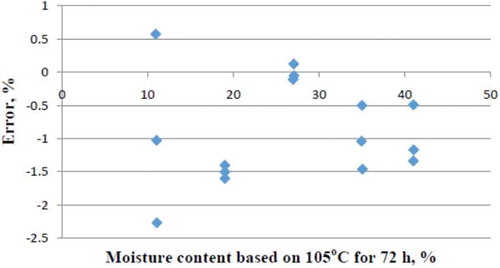
FIGURE 2 Percentage error differences between the 130°C for 2 h. Method versus moisture contents based on 105°C for 72 h.
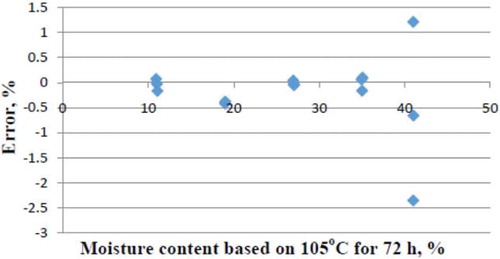
FIGURE 3 Percentage error differences between the 105°C for 5 h. Method versus moisture contents based on 105°C for 72 h.
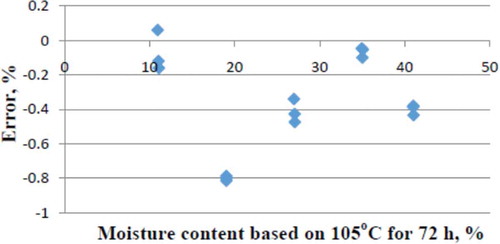
FIGURE 4 Percentage error differences between the 105°C for 48 h. Method versus moisture contents based on 105°C for 72 h.

Standard Deviations of Moisture Content Determination Procedures
Ground pearl millet
The standard deviation calculated for the moisture content determined using the base method (105°C for 72 h) and that of the three procedures for ground pearl millet, i.e., 130°C for 1 h, 130°C for 2 h, and 105°C for 5 h are shown in . It could be observed that at all moisture levels, the standard deviation calculated for the moisture content using 130°C for 1 h was generally higher than those calculated for the other moisture levels. The standard deviation for the moisture content determined using the other moisture content determination procedures were generally low but increased with increasing moisture content. This trend was reported by Chen[Citation5] for rough rice, Bowden[Citation14] for wheat and barley, and Young et al.[Citation22] for peanut pods, hulls, and kernels. In comparison to the other moisture content determination methods, the standard deviation for 105°C for 72 h and 105°C for 5 h methods were low in comparison to the other methods. The low standard deviation observed for the moisture content determined using 105°C for 72 h and 105°C for 5 h methods suggests that at the heating temperature of 105°C, the water residuals within the grain and the loss of volatile substance were minimal. Large variation in water residual and volatile substance loss could lead to large variation in the standard deviation of moisture content.[Citation5]
Whole pearl millet
The standard deviation calculated for the moisture content determined using the base method (105°C for 72 h) and that of the three procedures for whole pearl millet, i.e., 105°C for 48 h, 130°C for 16 h, and 130°C for 20 h are shown in . From the figure, no obvious trend could be observed; however, the standard deviation for the moisture content determined using 105°C for 72 h was generally higher followed by that of 105°C for 48 h method. Generally, lower standard deviation was determined for the 130°C for 16 h and 130°C for 20 h methods. This suggests that the temperature of 130°C was adequate to ensure minimal variation in residual water and volatile substance loss in pearl millet. It is important to note that low standard deviation recorded at particular air oven moisture content determination method does not necessarily mean that the temperature and time combination for the method is sufficient to completely remove all the moisture in the grain.
Regression Models
As earlier noted in the introductory part of this report, linear equations have been used by some researchers to establish the relationship between standard and apparent moisture content.[Citation5,Citation13,Citation15,Citation20–Citation23] In the calibration, standard moisture content was used as the dependent variable, while the apparent moisture content determined using the various moisture content determination methods was used as the independent variable. The regression models developed are as shown in The apparent moisture content could be used as an input in the models to predict the moisture content of pearl millet using the base method within the moisture content range of 11–41% (w.b). The models developed had very high coefficient of determination, R2 ranging from 0.9952–0.9999. A similar range of coefficient of determination was reported by Chen[Citation5] for rough rice. The close agreement of the predicted and the actual moisture content suggests that the models could eliminate the problem of energy consumption and time wastage encountered while heating at a high temperature and longer time.[Citation23] Predicting the moisture content of pearl millet using shorter heating time could provide a more rapid technique for moisture content determination of the grain. The use of microwave oven in partial drying of soybeans for rapid determination of moisture content without burning has been reported.[Citation23]
TABLE 3 Regression models for the 105°C for 72 h method as a function of other air oven moisture determination methods
The residual plots for the models shown in are presented in –.The clear random distribution of the residual for the models of the 130°C for 1 h (M130t1), 130°C for 2 h (M130t2) and 105°C for 5 h (M105t5) methods indicate that a linear regression model was appropriate to describe the relationship between the base method (105°C for 72 h method) and the other moisture content methods. However, non-linear regression models were appropriate for the 105°C for 48 h (M105t48), 130°C for 16 h (M130t16), and 130°C for 20 h (M105t20) methods, respectively, as can be seen from the residual plots (–).
FIGURE 9 Residual plot of the relationship between moisture content based on 130°C for 1 h and 105°C for 72 h.
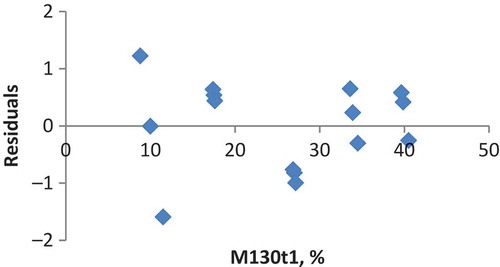
FIGURE 10 Residual plot of the relationship between moisture content based on 130°C for 2 h and 105°C for 72 h.
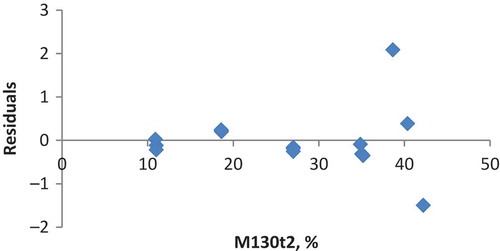
FIGURE 11 Residual plot of the relationship between moisture content based on 105°C for 5 h and 105°C for 72 h.
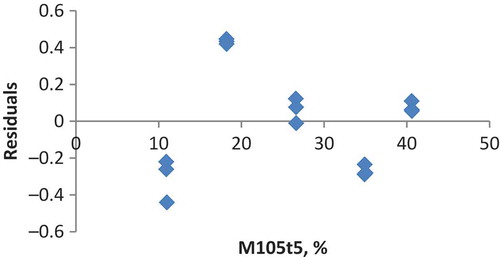
FIGURE 12 Residual plot of the relationship between moisture contents based on 105°C for 48 h and 105°C for 72 h.

CONCLUSIONS
Air oven moisture content determination methods for pearl millet in the moisture content range of 11–41% (w.b.) was investigated. The moisture content determined using the methods were significantly different (p < 0.05) at low moisture content but the significance of difference decreased as the moisture content of pearl millet increased. The temperature and time combination for the 130°C for 2 h, 105°C for 48 h, 130°C for 16 h, and 130°C for 20 h methods were sufficient to completely remove the moisture in pearl millet having not more than 35% moisture content (w.b.); beyond which the error increased. Generally, low standard deviation was observed for the moisture content determined using the 105°C for 72 h, 105°C for 5 h, 130°C for 16 h, and 130°C for 20 h methods. Linear models for predicting the grain moisture content were developed for the base method, 105°C for 72 h in relation to the other moisture determination methods. The models had very high correlation coefficients and the residual plots indicated the adequacy of the models.
REFERENCES
- Razavi, S.M.A.; Edalatian, M.R. Effect of Moisture Contents and Compression Axes on Physical and Mechanical Properties of Pistachio Kernel. International Journal of Food Properties 2012, 15(3), 507–517.
- Kara, S.B.; Turgut, N. Strength and Frictional Properties of Popcorn Kernel as Affected by Moisture Content. International Journal of Food Properties 2011, 14(6), 1197–1207.
- Zareiforoush, H.; Komarizadeh, M.H.; Alizadeh, M.R.; Tavakoli, H.; Masoumi, M. Effects of Moisture Content, Loading Rate, and Grain Orientation on Fracture Resistance of Paddy (Oryza Sativa L.) Grain. International Journal of Food Properties 2012, 15(1), 89–98.
- Khir, R.; Atungulu, G.G.; Pan, Z.; Thompson, J.F.; Zheng, X. Moisture-Dependent Color Characteristics of Walnuts. International Journal of Food Properties 2014, 17(4), 877–890.
- Chen, C. Evaluation of Air Oven Moisture Content Determination Methods for Rough Rice. Biosystems Engineering 2003, 86(4), 447–457.
- Grabe, F. Measurement of Seed Moisture. In Seed Moisture; Stanwood, P.C.; McDonala, M.B.; Eds.; Crop Science Society of American Special Publication No. 14: Madison, WI, 1989; 69–96.
- Hart, J.R.; Feinstein, L.; Golumbic, C. Oven Methods for Precise Measurement of Moisture Content of Seeds. Marketing Research Report No. 304 (USDA-AMS); US Government Printing Office: Washington, DC, 1959.
- United States Department of Agriculture. Oven Methods for Determining Moisture Content of Grain and Related Agricultural Commodities; Consumer and Marketing Service, Grains Division: Hyattsville, MD, 1971.
- Association of Official Analytical Chemists. Official Methods of Analysis, 13th Ed; AOAC: Washington, DC, 1980.
- ASAE. Standard Moisture Measurement—Grain and Seeds, 29th Ed; S352.1, St. Joseph: MI, 1982.
- Hart, J.R.; Neustadt, M.H. Application of the Karl Fischer Method of Grain Moisture Determination. Cereal Chemistry 1957, 34, 26–37.
- International Organization for Standardization. Cereals and Cereal Products-Determination of Moisture Content; Basic reference method IS0711-1978(E); International Organization for Standardization: Geneva, Switzerland, 1978.
- Jindal, V.K.; Siebenmorgen, T.J. Effects of Oven Drying Temperature and Drying Time on Rough Rice Moisture Content Determination. Transactions of the ASAE 1987, 30(4), 1185–1192.
- Bowden, P.J. Comparison of Three Routine Oven Methods for Grain Moisture Content Determination. Journal of Stored Product Research 1984, 20(2), 97–106.
- Noomhorm, A.; Verma, L.R. A Comparison of Microwave, Air Oven, and Moisture Meters with Standard Method for Rough Rice Moisture Determination. Transactions of the ASAE 1982, 25(6), 1464–1470.
- Williams, P.C.; Sigurdson, J.T. Implications of Moisture Loss in Grains Incurred During Sample Preparation. Cereal Chemistry 1978, 55(2), 214–229.
- Miller, B.S.; Lee, M.S.; Hughes, J.W.; Pomeranz, Y. Measuring High Moisture Content of Cereal Grains by Pulsed Nuclear Magnetic Resonance. Cereal Chemistry 1980, 57(2), 126–129.
- Dursun, E.; Durson, I. Some Physical Properties of Caper Seed. Biosystems Engineering 2005, 92(2), 237–245.
- Ojediran, J.O.; Adamu, M.A.; Jim-George, D.L. Some Physical Properties of Pearl Millet (Pennisetum glaucum) Seeds as a Function of Moisture Content. African Journal of General Agriculture 2010, 6(1), 39–46.
- Balascio, C. Calibration of Microwave-Oven Drying Techniques Versus Air-Oven Methods for Measurement of Peatmoss Moisture Content. Applied Engineering in Agriculture 1992, 8(2), 197–200.
- Wilhelm, L.R.; Perrin, D.R.; Barbar, D.J. Evaluation of Methods for Moisture Content Determination in Snap Beans. Transactions of the ASAE 1988, 31(3), 956–961.
- Young, J.H.; Person, N.K.; Donald, J.O.; Mayfield, W.D. Harvesting, Curing, and Energy Utilization. In Peanut Science and Technology; Pattee, H.E.; Young, C.T.; Eds.; American Peanut Research and Education Society: Yoakum, TX, 1982; 458−485.
- Sharma, N.; Hanna, M.A. A Microwave Oven Procedure for Soybean Moisture Content Determination. Cereal Chemistry 1989, 66(6), 483–485.

